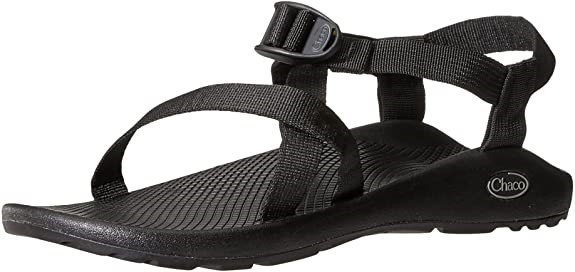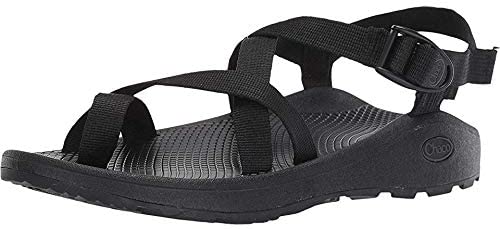Chacos are among the most popular sandals in the world, and they are an extraordinarily well known hiking option. If you’re in a mountain town or outdoor hub, you’ve probably seen plenty of Chacos in your day to day life or walking the trail.
Few sandals can compare with the comfort and durability that Chacos offer, but you may have wondered how good of a hiking shoe these outdoor sandals actually are. If you want to learn more about when to pack your Chacos for a hike, you’re in the right place!
The short answer is yes, Chacos are good for hiking. The longer answer is it depends on both your environment and personal preferences. While debris can enter the shoe, their construction offers great foot support, comfort, and durability for use on the trail.
Can You Hike In Chacos?
The lack of foot protection is one of the largest downsides to any hiking sandal, that being said, Chacos are a great, comfortable hiking shoe that many hikers swear by.
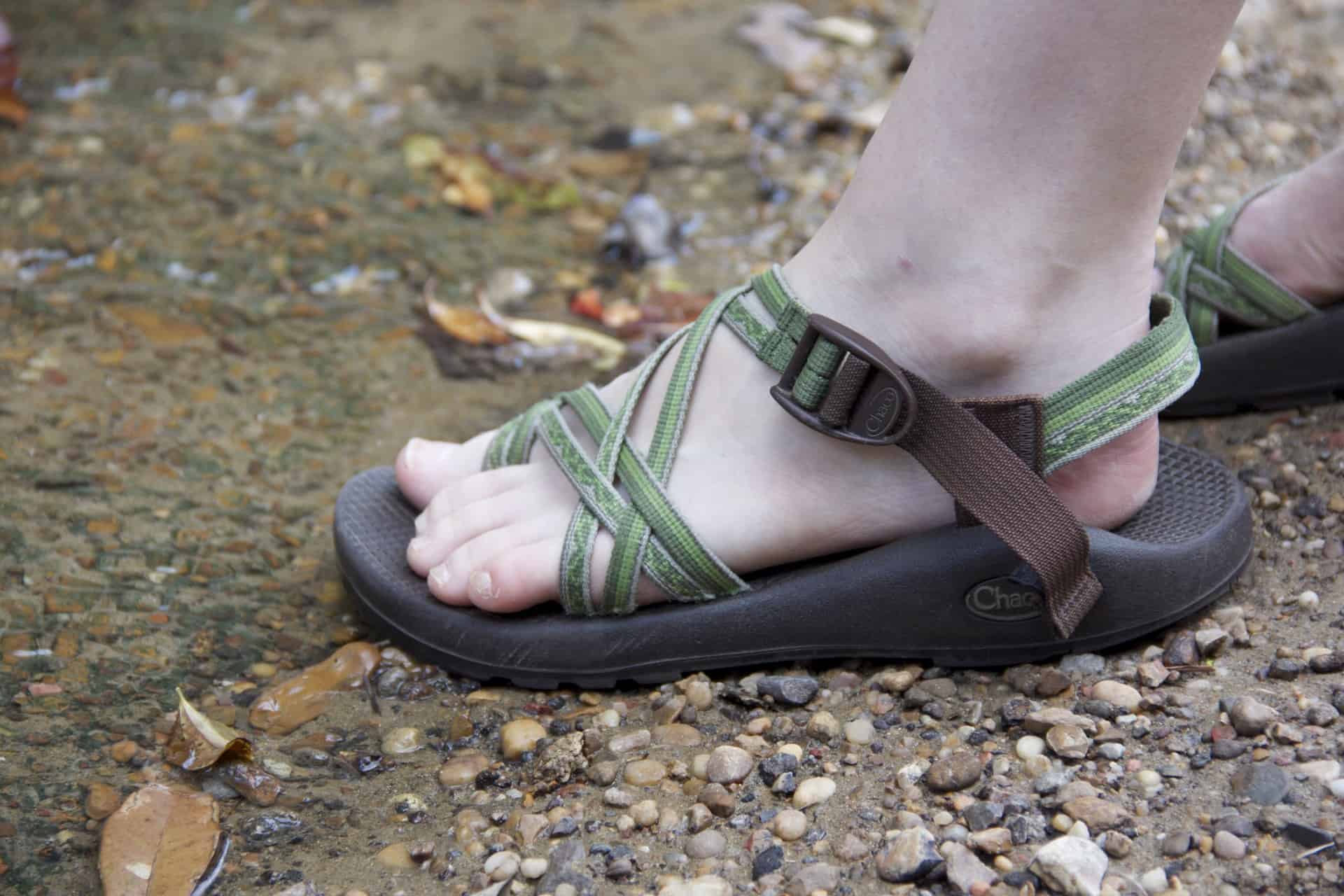
If you size the sandals properly, wear them on the right hikes, and take care of your feet you will be having a much better experience.
Chacos are an amazing choice for hikers in a large variety of situations, sports, and environments. but like any shoe, it’s a good idea to break them in first, and it’s beneficial to toughen up your feet if you plan to take them on hardcore journeys.
proper planning and caution make it relatively easy to avoid any potential problems.
Also Read: Are Duck Boots Good for Hiking?
Chacos History
Chacos began their history in 1989, with a whitewater rafting and fly fishing guide named Mark Paigen. Mark sought to create a sandal that would allow his feet to dry in the sun, and offer comfort and support as well.
Early Chacos were custom made by hand, and after tracing a client’s foot, a single piece of synthetic material and a buckle were used to secure the sandal.
Over the next couple of years, the sandals began to be sold in a small shop in Colorado, and Mark consulted a pedorthist to improve the design further.
The sandals evolved to offer aggressive arch support, quality materials, and comfort.
The Chaco Z/1 earned its name after a friend of Mark dubbed the newest iteration of the sandals “Zee one” in a terrible French accent.
Chacos have continued to improve their product, contribute to outdoor philanthropic efforts, and maintain their sandals as reliable shoes for the outdoors.
The Chaco logo is a Gecko (Gecko was the original name, but it was changed to Chaco, after Chaco Culture National Historical Park) to reflect the ability of the animal to thrive in so many environments, just like his shoes.
The Downside Of hiking in Chacos
While Chacos are a great option for many hikers and situations, there are still potential issues that they will face on the trail. Below are some possible problems, and what you can do to avoid them.
Abrasion/Blisters
Sandal straps can cause abrasion, and an outdoor product like Chacos will probably end up wet and/or sandy.
While you can normally end up a bit raw or dealing with hotspots from sandal straps, this scenario, in particular, can be extra abrasive and annoying.
I recommend packing some tape and a small towel to avoid your feet getting too beat up, especially if you’re putting in miles on a longer trip.
Also Read: Are Converse Good For Hiking?
Taping hotspots (Potential blisters) is a great trick to keep your feet in good health on a hiking trip, and it can be a lifesaver when wearing sandals.
Any athletic tape works great, and I’m also a fan of Metolius climbing tape for smaller problem areas. Chacos are sometimes sized wrong by hikers, and this leads to blisters.
If you size the shoes correctly and break them in properly, blisters are relatively unlikely for the sandals.
Your feet also tend to toughen up over time in sandals, so if you generally wear closed-toed shoes and don’t go barefoot, keep in mind that your skin will get stronger over time.

I also recommend attempting to adjust the strap if you feel that you are developing blisters, as this is a common issue for hikers/Chaco users.
If you properly size your sandals and keep an eye out for hotspots, you probably won’t develop any blisters.
Generally, blisters are caused by friction and moisture from your feet being cooped up in shoes and sweating. While blisters are still possible, the breathability of Chacos will allow you to avoid the largest factors that contribute to blisters.
Debris
Everything from loose rock, dirt, sand, leaves, and so on can end up in your sandals.
This isn’t a huge problem, just keep in mind that you may have to make stops along the way to clear out debris buildup.
There’s no true fix for this problem, the most you can do is try to watch your step and avoid what you can.
Some models are tapered upwards on the edges of the shoe to assist in preventing debris from getting into the shoe.
Since the sandals are fairly open-air in their design, it’s relatively easy to remove any rocks, dirt leaves, and so on from the shoe.
Sunburn
While many love a sick set of Chaco tan lines to show off, sunburn is also a possibility.
if you plan to be in the sun all day you may already have sunscreen in your pack,
just don’t forget to apply it to your feet as well. This could be especially painful if you’re on a longer hiking trip!
Snake and insect bites
It’s not majorly likely, but with your feet exposed you’re more likely to be bitten by a snake, insect, or animal.
Again, the only true thing you can do to avoid this is to watch your steps. Make sure to keep an eye on where you’re going, and give animals space when you run into them on a hike.
A broken strap
Chacos are typically very durable, but there’s always a possibility that a sandal strap can break, especially if you’re wearing a long-time used and abused pair.
Worst case scenario you can try to rig something together with some trailside sewing, or maybe taping them up until you’re back home.
Keep in mind that there are always other issues that could happen, but these are just a few things to keep in mind if you’re wearing your Chacos on a hike.
Many of the potential problems that could occur are unlikely, but you should always consider what may take place on a hike.
Also Read: Are Blundstones Good for Hiking?
The positives of hiking in Chacos
The primary positives of hiking in Chacos are comfort, foot support, and breathability. Chacos were among the first brands that the American Podiatrist Medical Association as an arch-supporting sandal.
They state that the arch support prevents over-pronation (Inward rotation of your foot when a step lands) of the foot, the raised heel and heel cup provide stability, and they say wearing Chacos can improve body alignment, prevent heel pain, and minimize pain from plantar fasciitis.
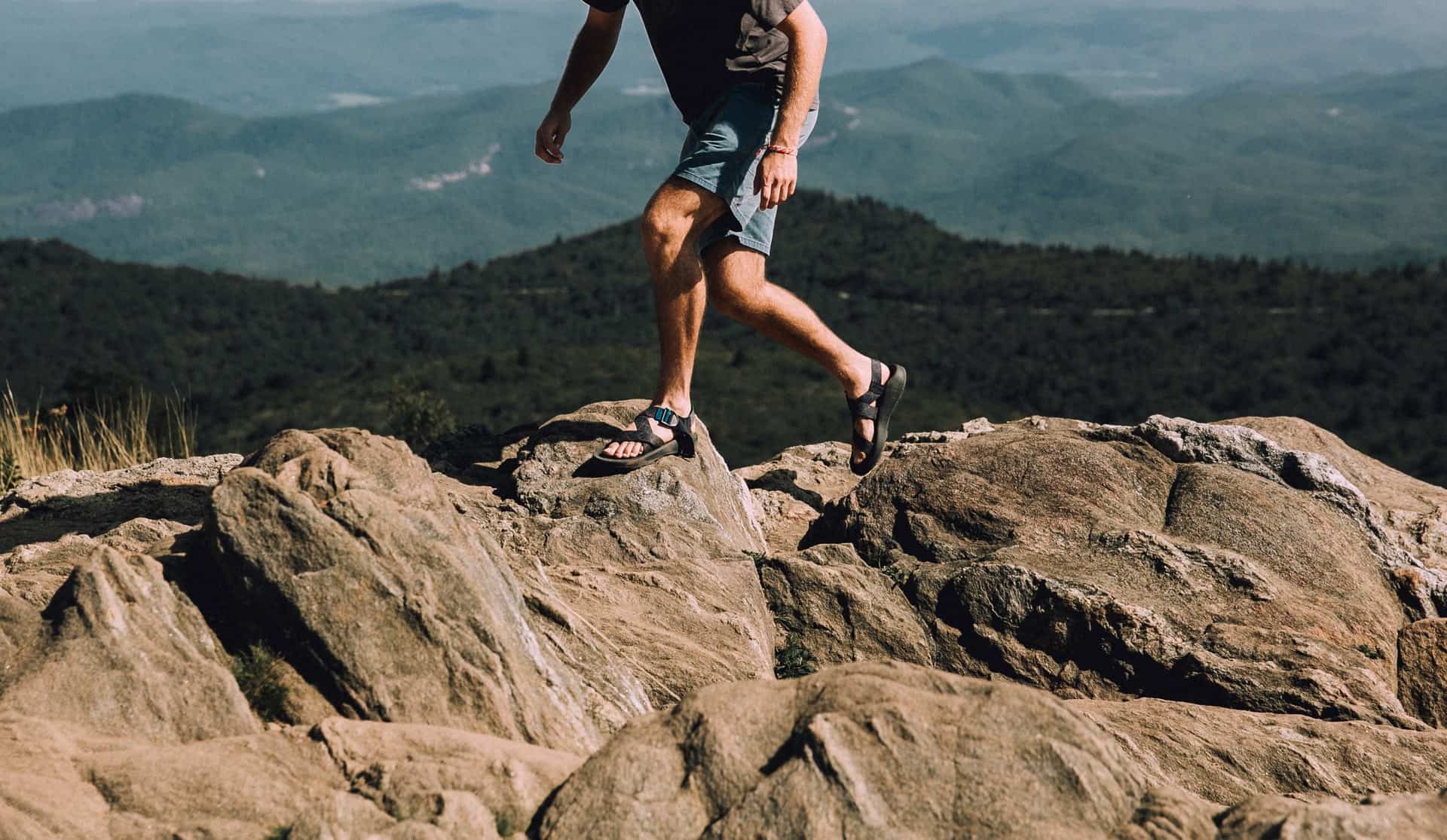
The fact that Chacos are not closed-toe is also greatly helpful for comfort, especially in warmer months. Hiking footwear can be quite warm in hot weather, so many welcome the breathability of a sandal with open arms.
Crossing streams and rivers can also be easier, considering that you may not have to change socks or avoid deeper areas so you aren’t stomping around in wet boots for a while.
For those who enjoy aquatic outdoor sports, the ease of drying your feet in Chacos is a massive bonus. As described earlier, this is also a significant factor in reducing your chances of developing blisters.
Also Read: Are Timberlands Good for Hiking?
Another bonus of hiking sandals like Chacos compared to boots is the lightweight design. Hiking boots are great for protection and ankle support, but heavier footwear is comparable to an extra 10 pounds in your pack. For many, the lightweight nature of hiking in Chacos is worth the potential drawbacks.
For some hikers, the Chaco tan line is a badge of honor. The iconic style of straps leaves the obvious criss-cross tan lines on your feet after long periods of hiking, and that may be a bonus for you.
This will vary from person to person, but chances are that if you’re rocking your Chacos for a long trail journey, you’ll have some interesting tan lines on your feet marking your journey!
Also Read: Can You Run In Hiking Shoes?
When should you hike in Chacos ?
Realistically you can take Chacos into most hiking situations and perform well. The Z/Chaco models are best for hiking, and they have several styles with extra traction and support if you’re worried about slipping or scrambling.
As long as you aren’t hiking in the Chillos models, you shouldn’t have too many problems.
I also recommend putting up the Chacos and lacing up your boots if you’re especially prone to ankle injuries, or if you expect to need protection for your toes and feet on a hike.
While this is rare, it’s possible and should be a consideration when taking sandals hiking.
What is the best Chaco model is good for me?
Are Chacos Good for Winter Hiking?
Personally, I consider Chacos to be a warmer weather hiking item, but if you’re set on taking them on the trail in the cold, or you don’t have another pair of shoes handy, you may need to throw on a pair of socks.
Yes, the dreaded socks and sandals combo can be a helpful option. While socks and sandals may not be your favorite combination for trail fashion, keeping your feet warm takes priority.
I recommend a pair of merino wool hiking socks if possible. I’m a big fan of Darn Tough hiking socks. They perform great, come in several sizes, styles, and weights, and they’re antimicrobial to boot.
Some hikers also swear by toe socks with Chacos. Ultimately, it comes down to your personal preference and what model of sandal you are using. The Z2 Chacos loop around the big toe, so toe socks would be necessary for that model.
best chaco sandals for hiking
Chacos offers several styles of footwear, ranging from sandals and flip-flops to boots. Generally, I would recommend their traditional style sandal models for hiking (Z/1 Classic, Z/2 Classic, Mega Z Cloud, Z Cloud, etc.).
I will cover the benefits and features of some Chaco sandals styles, including options that are not as suited to traveling trails. The biggest thing I can recommend for anyone looking for hiking footwear is to try on the item you want to buy.
There are products better suited to specific situations like hiking, but ultimately the thing that matters most is how the product fits your foot, and how comfortable it is.
Chacos can be somewhat difficult to fit at first, but if you purchase the correct size and adjust the straps correctly, they fit nearly as well as many custom shoes.
Z/1 Classic
As the name implies, the Z/1 is the original style model of Chacos sandals. This is the product that Mark Paigen built his original, improvised sandals into, and what made Chacos a juggernaut company.
This model is built from a total of 8 parts (A positive for me, fewer parts means less that can break).
The LUVSEAT PU footbed is podiatrist-approved, offering great support for anyone, even those with foot problems. The sandals are adjustable, so they fit your foot like a custom shoe. The straps are threaded through the midsole to offer extra stability.
While my first instinct was to describe the Z/1 as the “Barebones” model of Chacos, they’re still a spectacular product and hard to beat for anyone seeking a pair of hiking sandals.
Several colors are available as well, and they are vegan-friendly in their construction.
Z/2 Classic
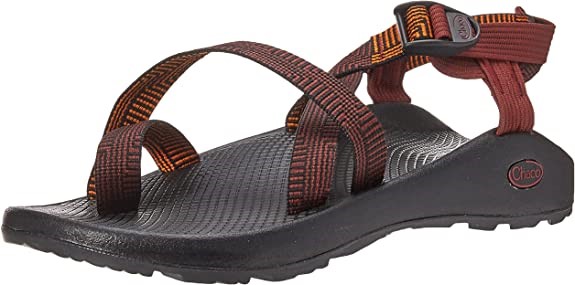
The Z/2 is very similar to the Z/1, it simply offers some extra features that are helpful for hikers. It has the same LUVSEAT PU footbed, adjustable straps, and similarly minimalist construction.
The Z/2 adds a loop around the big toe to offer a bit more security, and the outsole is made with ChacoGrip rubber, which essentially offers a bit more traction. Both options have a 3.5mm lug depth.
Mega Z/Cloud
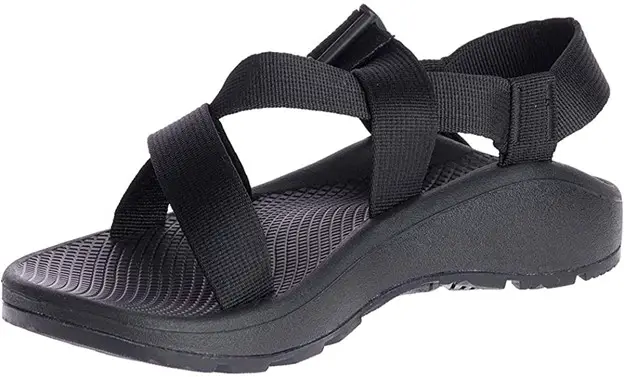
The Mega Z/Cloud is the burlier version of the above Chaco models. It features a ChacoGrip rubber outsole, Chaco cloud cushioning, wider 35mm polyester jacquard webbing straps, adjustable heel risers, and dual-density LUVSEAT PU midsoles. Overall it’s similar to the Z/1, just built as a larger product with some extra comfort features.
Z/Cloud and Z/Cloud 2
The Z/Cloud and Z/Cloud 2 Chacos are built very similarly to the Z/1 and Z/2 classics, they just feature a more cushioned LUVSEAT PU sole.
If you prefer a cushioned shoe, the Cloud models are right up your alley. However, the classic models are more supportive in comparison.
I recommend trying on both styles and seeing what fits your needs better.
While there are many more styles of Chacos available, the classic and cloud model sandals are generally better suited to the needs of hikers.
Typically, people prefer the sandal options from Chaco, but they offer closed-toed shoes as well. Items like the Chacos Chillos Slides are made well, but they aren’t designed to be used for outdoor sports and activities like the original style models are.
If you find a different Chacos style that you feel is better suited to your activities, that’s great too. I’m simply offering a place to start your search.
Conclusion
Chacos can make a great hiking shoe when used in the correct situations. As long as your shoes fit well, and you’re not in something like the snow, they’ll hold up great to most hiking scenarios.
People have hiked the entire Appalachian Trail in Chacos, so they can hold up to adventures both big and small.
If you’re planning to practice some aquatic outdoor activities, want some extra breathability in warm weather, or simply want a lightweight shoe on the trail, then Chacos are among the best items a hiker can have.
If you break in your sandals, keep a roll of tape on you, and watch where you step, then your feet will be happy for your entire hike in Chacos.
For more related guides read my other posts:
About the Author

Hussain is a passionate hiker and traveler that love the outdoor and enjoys what nature has to give, whenever he can he love to write and give tips & honest reviews to help others get out there and just seek more unforgettable experiences.

